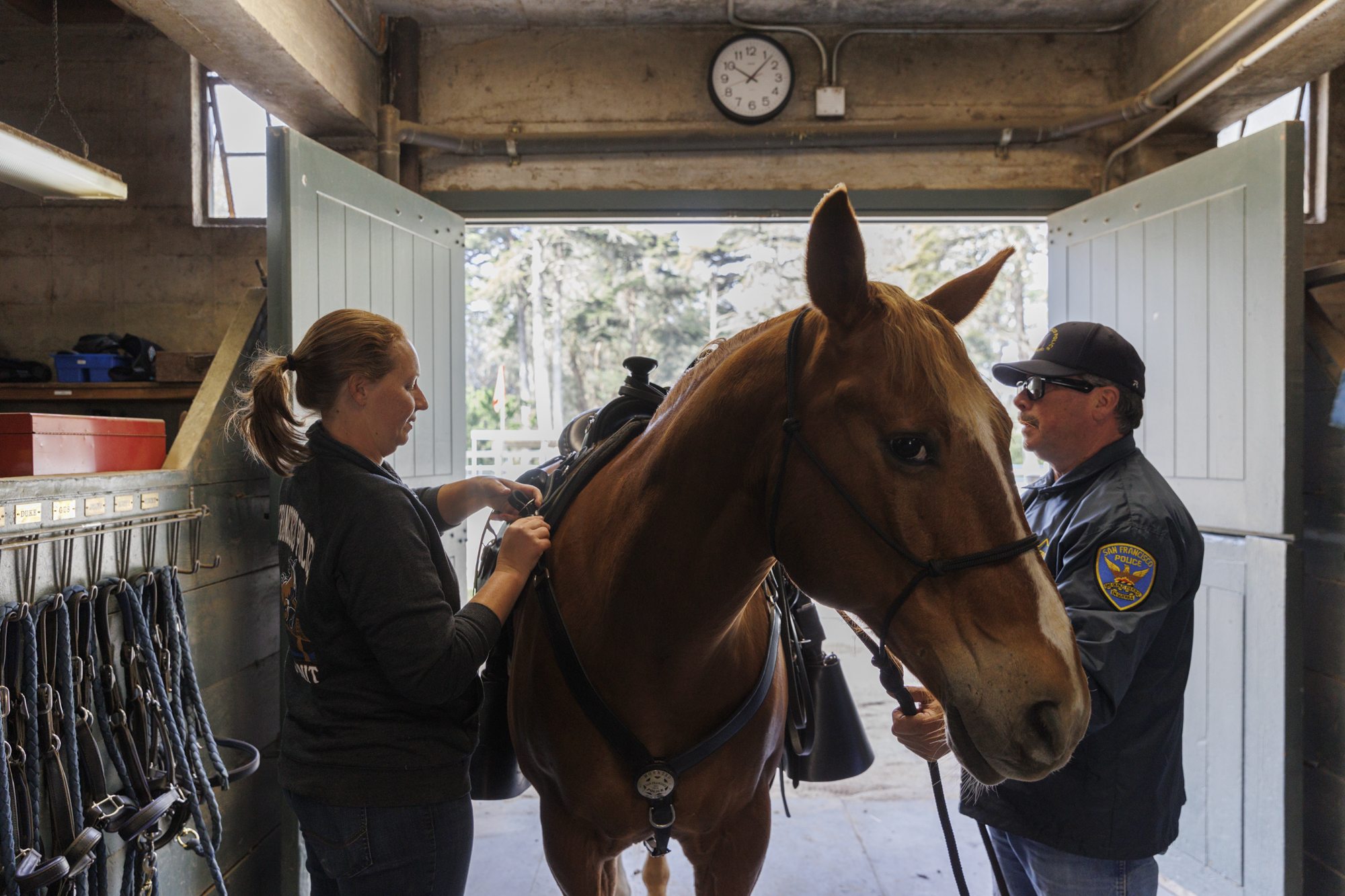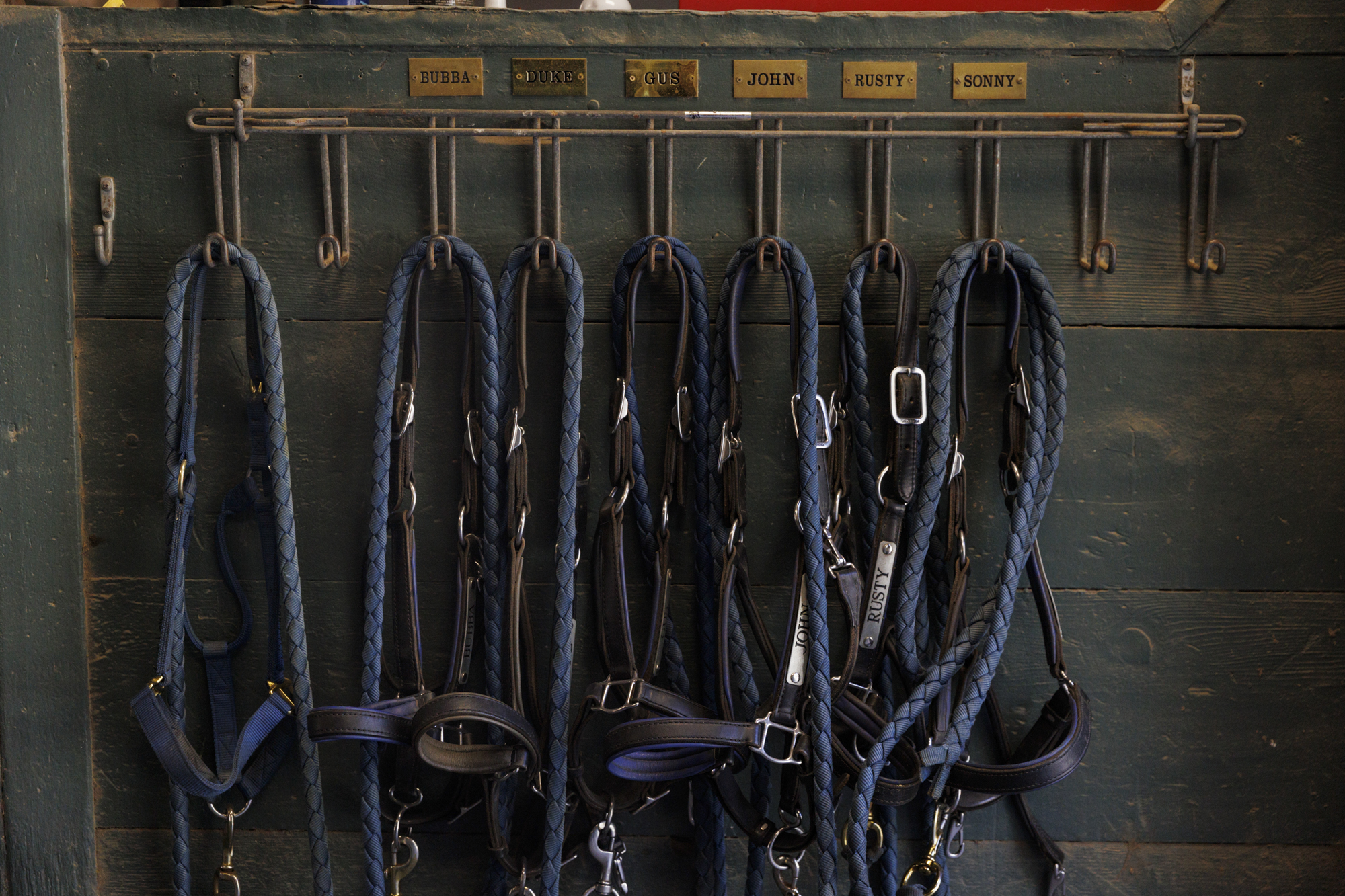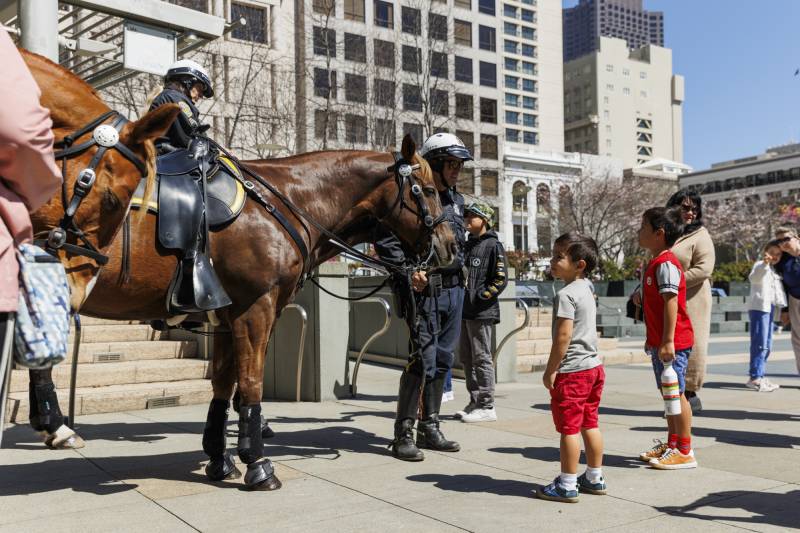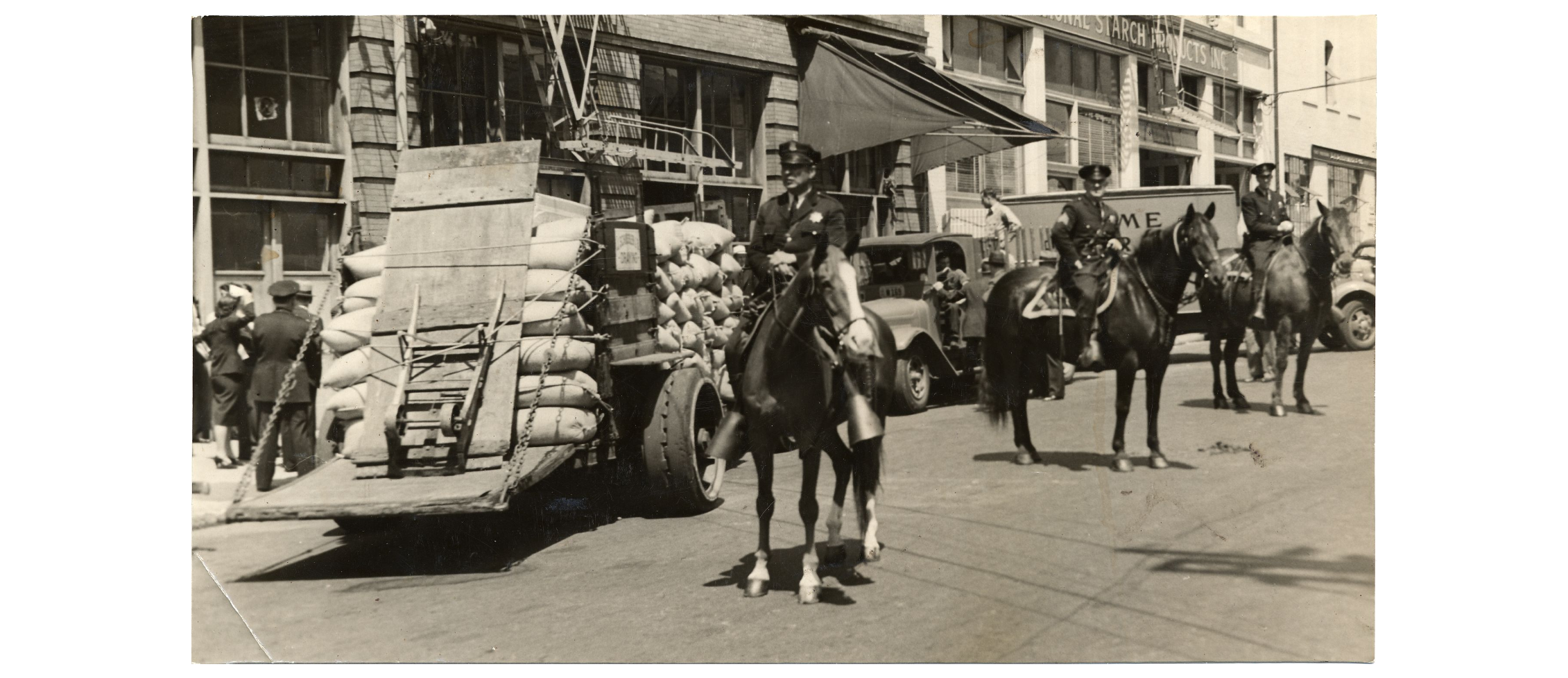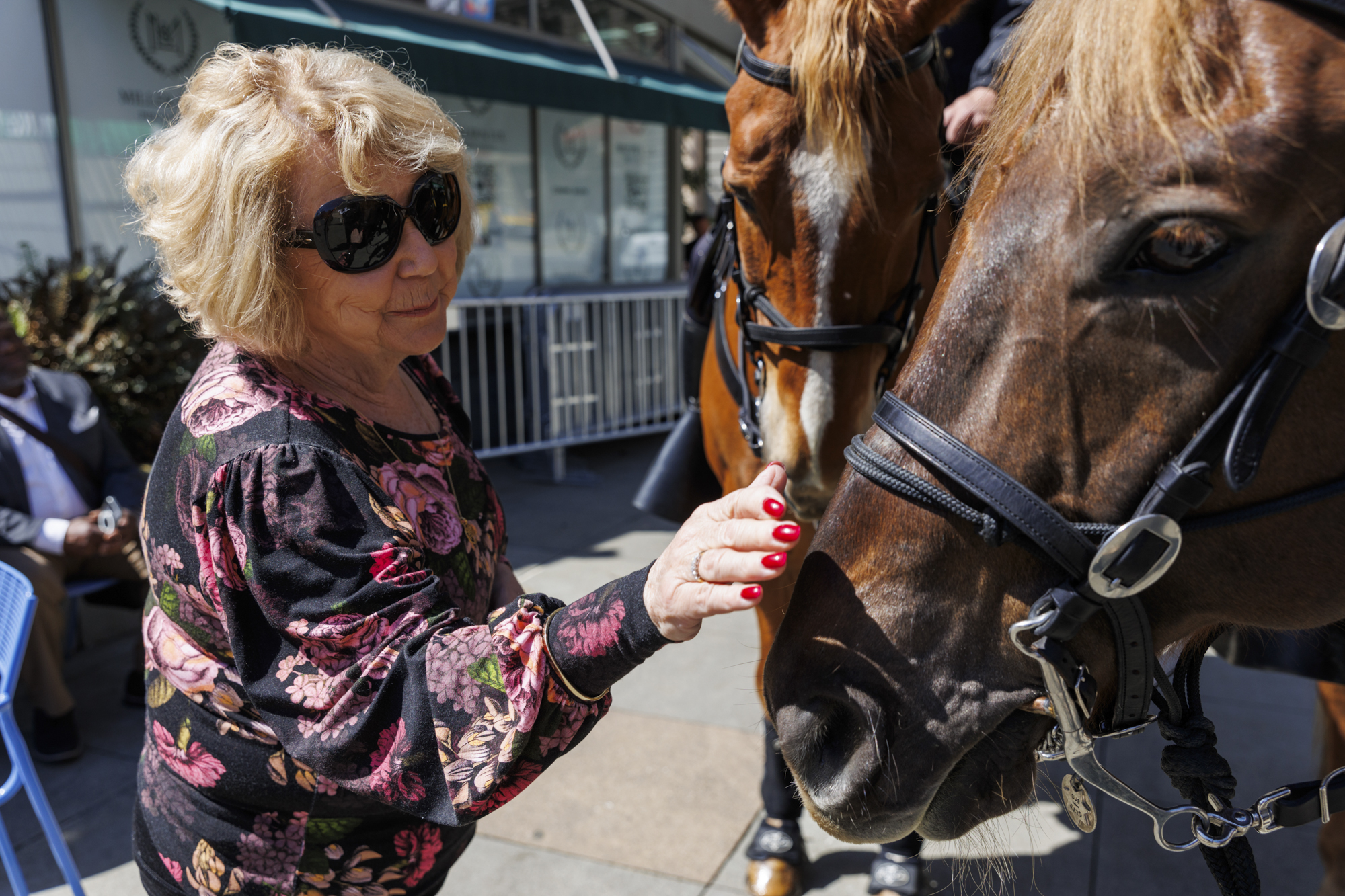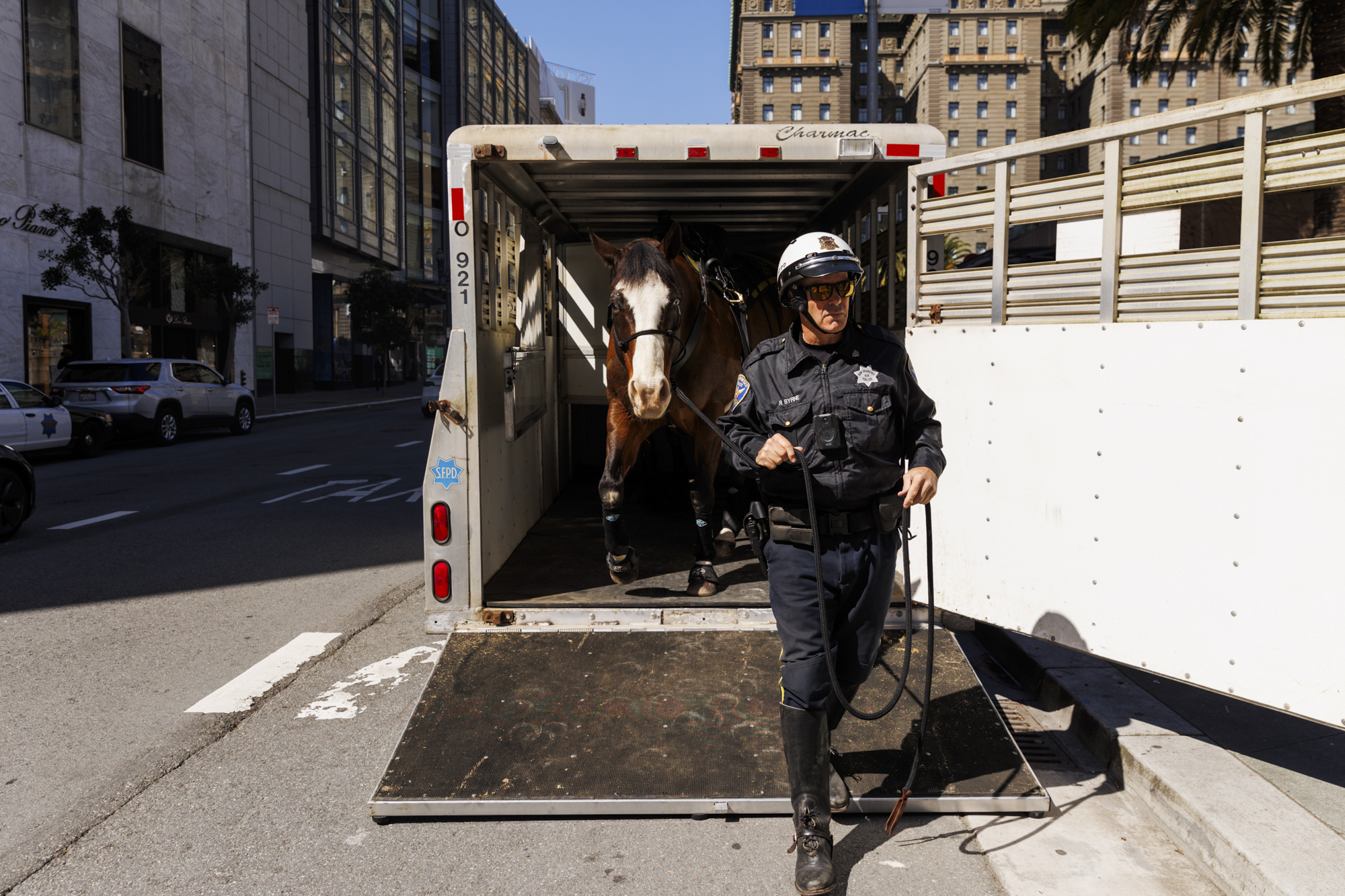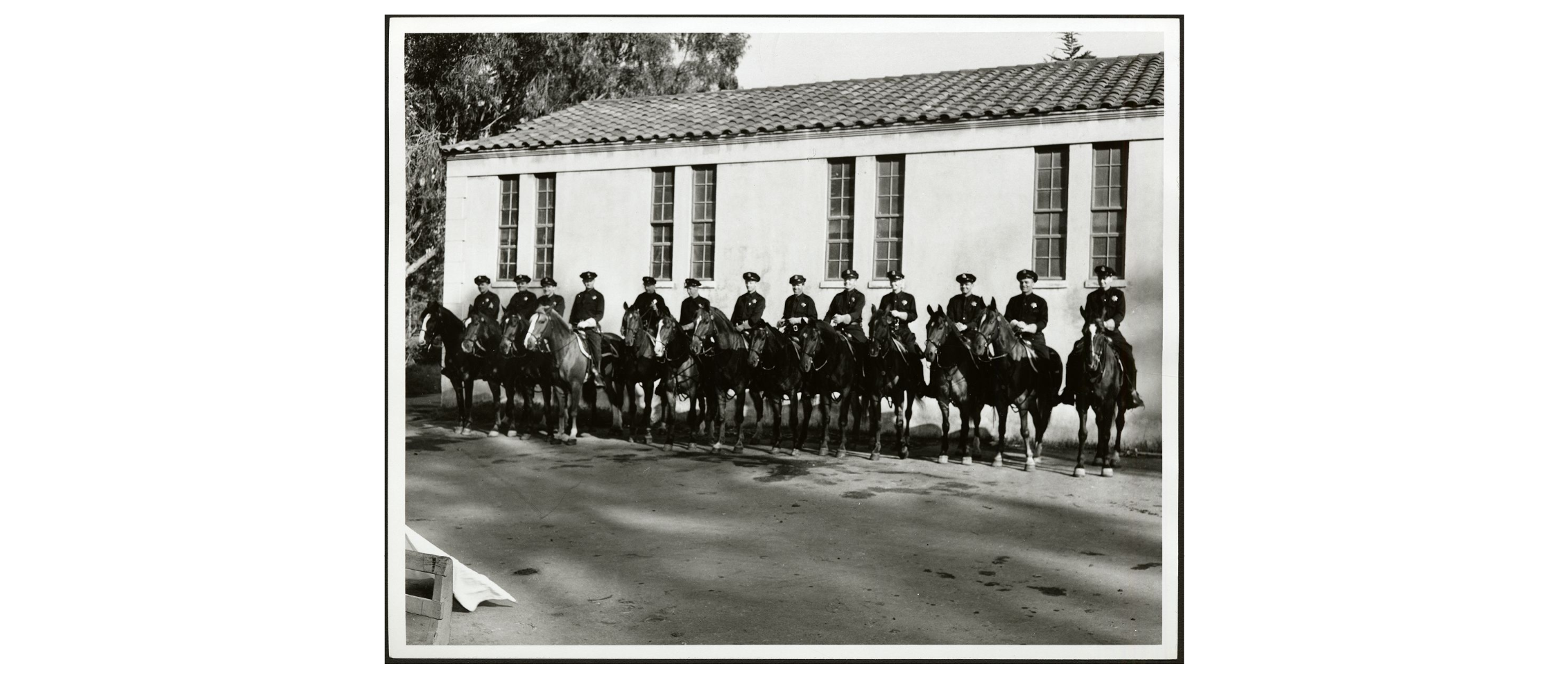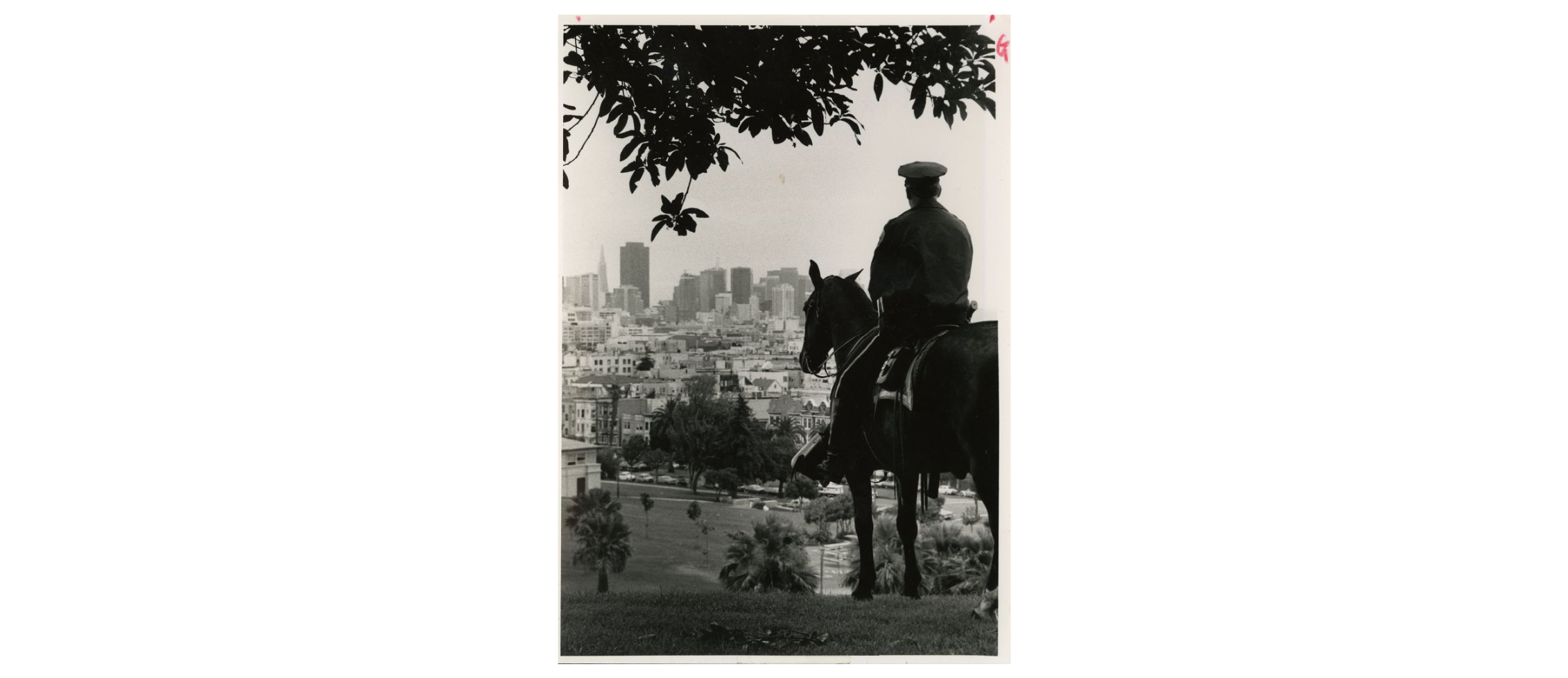Episode Transcript
Olivia Allen-Price: I’ve got a 3 year old and he’s super into emergency vehicles right now…
[child mimics emergency vehicle siren]
Olivia Allen-Price: and he’s often mimicking fire trucks, ambulances and police cars…
[child mimics emergency vehicle siren]
Olivia Allen-Price: So I was delighted to share with him that this week Bay Curious was digging in on another — less abrasive sounding — way that police get around.
[sound of horse hooves clacking]
Olivia Allen-Price: On horseback! Our question asker first noticed San Francisco police on horseback at the 2022 Golden State Warriors parade….
News Reel: And what a celebration it was, thousands of warriors fans…
Abby Van Soest: They were sort of leading a, like, part of the procession. My name is Abby Van Soest, and I live in the Excelsior District of San Francisco.
Olivia Allen-Price: Once Abby noticed them, she started seeing the mounted police at events all over the city. It got her thinking.
Abby Van Soest: I’m curious about why they still exist and what they’ve done in the past. Also, I just want to know about the horses. [chuckles] ]Like, are there, like, different personalities? Do they bring out different horses for different events? What does the care of taking care of them go into? Yeah. All of that stuff.
Olivia Allen-Price: San Francisco has the second oldest mounted police unit in the country…after New York City. They’ve been around more than a hundred and fifty years. Today on the show, we’ll meet the horses and their riders…learn how their role on the force has changed over time…and get a sense of what their day to day lives look like. I’m Olivia Allen-Price and this is Bay Curious.
[child neighs]
[Sponsorship Message]
Olivia Allen-Price: Have you ever seen police on horses walking through Golden Gate Park or down city streets…and wondered…what’s up with that? We sent Bay Curious producer and editor Katrina Schwartz to learn more about the history and purpose of some of the police force’s most majestic members…
Katrina Schwartz: The San Francisco Police Stables are tucked away next to the Polo Fields in Golden Gate Park. Unlike a lot of other stations, it’s quiet here with just the sounds of birds chirping, a few lawnmowers, and the horses of course.
[sound of horse hooves clacking]
Theresa SanGiacomo: Oh, Rusty Roo!
Katrina Schwartz: Yeah who’s this we see?
Theresa SanGiacomo: This is Rusty. He’s our resident artist and you think I’m joking, but I’m not. He’s learned how to paint. He’s a sweet, sweet, sweet horse.
Katrina Schwartz: His art is abstract and he favors the color red. There are currently six horses living here: Rusty, Bubba, Sonny, John, Duke and Gus. Bubba is the smiler. And John is Mr. Reliable.
Katrina Schwartz: Hi. Do you like that microphone?
[horse mouth noise]
Katrina Schwartz: Oh, yes you do
Theresa SanGiacomo: Well, you know, he can’t be too sure. It may be a cover for a carrot. You know, who knows?
Theresa SanGiacomo: My name is Theresa San Giacomo. I’m a sergeant in the police department assigned to the mounted unit.
Katrina Schwartz: Because the mounted unit is stationed in Golden Gate Park the public is free to wander by and pet the horses if they’re near the fence.
Theresa SanGiacomo: We’re standing in the police stables, which is also our station. It’s a police station in a barn. Two and one.
Katrina Schwartz: The barn is a massive concrete affair built in the 1930s. Theresa is giving me the grand tour…
Theresa SanGiacomo: We have pictures in the barn dating back to the late 1800s.
Katrina Schwartz: It clearly used to house more horses than it does now.
Theresa SanGiacomo: Each horse has their own equipment. Their saddles are specific for them, for their body shape, their size.
Katrina Schwartz: It’s evident Theresa and all the police officers and stable staff are very fond of their four-legged co-workers.
Theresa SanGiacomo: They have stars. And so it has their name on it instead of a number.
Katrina Schwartz: Theresa has wanted this job for a long time.
Theresa SanGiacomo: it sounds like a B.S. story, but it’s honest to God, true. I was a young girl. We were at Christmas time. We’re at pier 39. We were all dressed up. And I saw two cops on horse posing for pictures. And my mom remembers it and I remember it, I looked at my mom and I said, I want to do that when I grow up.
Katrina Schwartz: She joined the San Francisco Police Department in 1995 and immediately put her name on a list of officers interested in serving in the mounted unit. But it’s a long list. Theresa only made it into the unit in 2019…24 years later.
Theresa SanGiacomo: I have posed for more pictures and talked to more young people in the Tenderloin on a horse than I probably ever did walking the beat. It is a barrier breaker to communicate with people.
Katrina Schwartz: The mounted unit has shrunk over the years. Currently there are only 3 officers and six working horses. So, more horses than riders. And that’s where Katie Corrigan comes in.
Katie Corrigan: We like to keep their minds busy as well as their bodies busy.
Katrina Schwartz: Katie is a stable attendant.
Katie Corrigan: We use a lot of these props.
Katrina Schwartz: She shows me a horse stall filled with items she uses to train the horses.
Katie Corrigan: We have trash can lids.
[metal clangs]
Katie Corrigan: You know, you’re walking down the street, you’re going to hear somebody opening their trash can, dropping their trash can lid. All sounds that can be startling. So we use that here at the barn, get the horse used to it so when it’s out there, it’s like, oh I’m familiar with that sound, no big deal.
Katrina Schwartz: The city is full of things that startle horses…muni bus air brakes, kids shrieking in bounce houses, bubbles…
Katie Corrigan: Sonny is one of our horses. When I start to blow bubbles, he comes running to them. He loves it. He’ll actually blow into the wand himself to make them.
Katrina Schwartz: And the horses get plenty of time to rest and nap in the sun too. But it isn’t all fun and games.
Katrina Schwartz: They may seem out of date, but mounted officers are still cops. And when the first mounted officer was sworn in June 1, 1874, horses were the best available technology…the fastest way to get around. And they would have put officers at an advantage over most of the public who would be on foot. Theresa says back then many of the police stations were mounted units.
Theresa SanGiacomo: A little known fact: Richmond Police Station used to be a horse police station. Ingleside police station were stables, so they were all over the city.
Katrina Schwartz: But as cars became more common, the police took up the new technologies. The mounted unit shifted to focus more on patrolling Golden Gate Park and the beach and doing community engagement. They’ve also been used to help with crowd control – like during the Iraq war protests in 2003. Theresa was a Tenderloin beat cop at the time, and not working with the horses yet.
Theresa SanGiacomo: There was maybe 40 to 50 officers, including myself, on Market Street with a crowd of about 200,000 coming down Market Street towards us.
Katrina Schwartz: She says the protest was peaceful, but police needed to clear the street of people so buses and cars could pass. Protesters weren’t listening to her and the cops on foot. But then the cops on horses and motorcycles arrived.
Theresa SanGiacomo: It can become very confrontational very quickly. Escalates, emotions are high, but officers on horses and dirt bikes were able to do it with one pass. It was incredible.
Katrina Schwartz: Horses have been used for crowd control because they’re big and intimidating. People tend to get out of the way when a horse advances towards them. But having a horse in a crowd can be risky too. There were a few times in the early 2000s where horses injured people — so Theresa says they’ve stopped using them in crowd control situations. At this point, you might be wondering, why do we even have a mounted unit anymore?
Katrina Schwartz: Well, in the late 1980s, city leaders had the same thought and tried to save some money by cutting the mounted unit. That led police supporters to propose a ballot measure that enshrined the mounted unit in the city charter. It passed by a huge margin… more than 85-percent of the vote.
Theresa SanGiacomo: And so now, we are protected by city charter. So the police department has to have a mounted unit.
Katrina Schwartz: I guess San Franciscans like their traditions! The most common place to see them now is at the head of parades…or bringing some pomp and circumstance to grand events, like the memorial for Senator Dianne Feinstein. And they do a lot of community engagement.
Theresa SanGiacomo: It really, truly is amazing to interact with people on a horse. And I think San Franciscans deserve that. They deserve officers in their neighborhoods that they are comfortable approaching and talking to.
Katrina Schwartz: Theresa says a lot of people have negative associations with the police. They’ve had bad experiences or associate sirens with danger. But the horses change the dynamic.
Theresa SanGiacomo: It usually starts with, oh my gosh, horse. Can I pet your horse? Can I take a picture? But then it transitions to, you know, how’s things? How are you doing today? Any help you need? You know, giving them phone numbers for resources, resource centers, outreach centers. And not just young people, all people.
Katrina Schwartz: Mounted unit officers and horses go out patrolling almost every day. They either head out the front gates to patrol Golden Gate Park or load the horses into trailers and take them to other parts of the city. Theresa suspects they are sent to be a visible presence in areas experiencing more crime. They give tickets, respond to crimes and make arrests like other officers.
Theresa SanGiacomo: We were down in Washington Square in North Beach a few months ago.
Katrina Schwartz: Theresa and another officer were on a routine patrol in North Beach.
Theresa SanGiacomo: There was something going on that shouldn’t have been going on.
Katrina Schwartz: A person was grabbing food off plates, harassing outdoor diners. To protect the horses, Theresa says mounted officers try not to dismount. She called for back up from a patrol car and followed the person on horseback.
Theresa SanGiacomo: You can see over everything you have what would be the equivalent of a bird’s eye view of things going on around you.
Katrina Schwartz: And once the squad car officers stopped the man, Theresa did the paperwork. No matter where officers are assigned to patrol, the day starts at the stables. Officers spend some quality time with their horses, cleaning and grooming them.
Theresa SanGiacomo: If they’re extremely dusty or dirty, we vacuum them.
Katrina Schwartz: Then they brush their tails and manes. Scrape out the sand and rocks from their hooves.
Katrina Schwartz: And make sure their saddles are in good shape.
[Jangling sounds]
Katrina Schwartz: Today Sonny and Bubba are heading out on patrol with officers Eric and Theresa. They mount up and head out the front gate to patrol their home turf — Golden Gate Park.
Theresa SanGiacomo: [at a distance] Alright, See you later! Bye!
[horse hooves clacking]
Olivia Allen-Price: That was Bay Curious producer and editor Katrina Schwartz. This is Katrina’s last story for Bay Curious for a while because she’s headed out on maternity leave! We wish you all the best in this exciting new chapter, Katrina
Also some warm welcomes! Ana De Almeida Amaral is joining Bay Curious as an intern and producer Amanda Font is returning to the show after welcoming baby Theo into the world.
Abby Van Soest: Bay Curious is made in San Francisco at member-supported KQED.
Olivia Allen-Price: This show was edited by me, Olivia Allen-Price.
Katrina Schwartz: Produced by Katrina Schwartz, Amanda Font, and Christopher Beale.
Olivia Allen-Price: Big thanks to Abby, our question asker this week. Thanks also to Alex Gonzales and Rachael Myrow. I’m Olivia Allen-Price. You’ve been listening to Bay Curious. Ye-haw.
